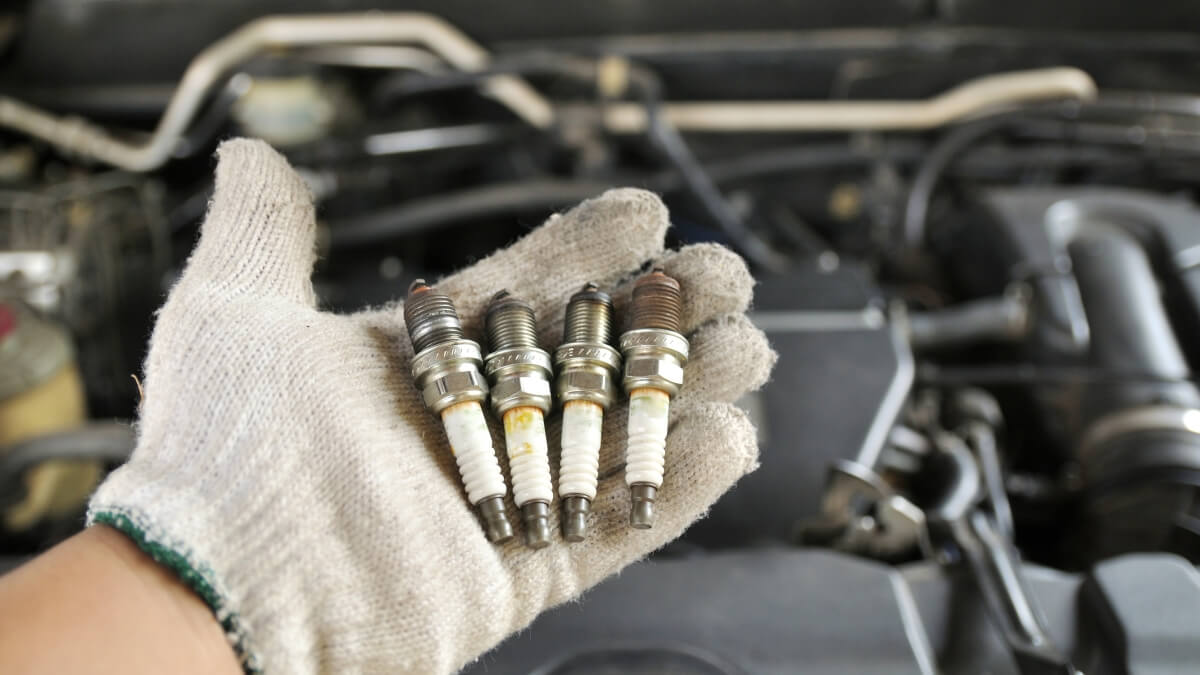
Changing the spark plugs in your car or truck is a necessary maintenance procedure that often goes overlooked. Today’s modern vehicles use computers to control the performance of an engine and can compensate for many of the poor performance problems that indicate that it is time to change spark plugs.
Vehicle manufacturers usually will indicate a service interval for spark plugs in the owner's manual. A repair manual or workshop guide will also offer advice for when to change spark plugs. Spark plugs come in a variety of designs, some that last longer and others that perform better, and each type will have a specific service life and service procedure.
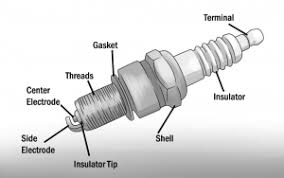 The anatomy of a spark plug has remained almost unchanged since the late 1800s
The anatomy of a spark plug has remained almost unchanged since the late 1800sOlder cars might require more frequent plug inspections, and it is a good idea to check them every 35,000 miles.
Noble metal spark plugs, which use elements like Iridium and Platinum, once were reserved for high-performance cars and trucks, but increasingly, economy cars like the Hyundai Elantra are using noble metal plugs to meet demanding fuel economy levels and to increase service intervals.
Newer cars that use noble metal spark plugs might go 100,000 miles or longer before requiring a spark plug change, but should be inspected every other year to ensure the plugs are in good condition. Noble metal plugs are more expensive than copper plugs but usually will provide better performance and longer service life.
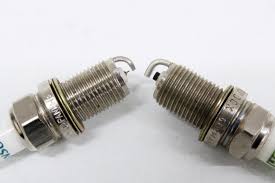 The difference between an Iridium and a Copper electrode.
The difference between an Iridium and a Copper electrode.Always replace plugs in sets, and always use the type of spark plug recommended by your service and repair guide or owners manual.
Signs that Something Isn’t Right
Often, what happens when spark plugs go bad might go unnoticed for a while before the problems become severe.
The most common problems that indicate poor plug performance are lack of power and poor fuel economy. Monitoring fuel economy is often the best indicator that an engine is not working as well as it should. If you see that your fuel mileage has dropped, but your driving habits haven’t changed, it might be time for new spark plugs.
You may also notice that your car or truck isn’t as fast as it used to be. You might notice that it is difficult to accelerate when passing, or that your vehicle is struggling to climb steep hills when it did not use to have trouble.
Car owners will see several benefits of changing spark plugs. Typically, fuel mileage will increase, performance will be improved and the engine may even run cooler. Changing plugs according to the service interval recommended for your vehicle will help reduce long-term damage to other, expensive components, such as catalytic converters that deteriorate from excessive emissions caused by poor plug performance.
How To Remove, Inspect and Replace Spark Plugs
As with any maintenance procedure, it is important to set aside enough time to do the job without rushing. How long it takes to change spark plugs depends on several factors that include the number of plugs, accessibility, and how difficult the plugs are to remove.
A modern, four-cylinder Toyota may take longer to change plugs than an older V8 truck, because the plugs may be more difficult to access. Long service intervals help reduce the frequency of spark plug replacement.
A service manual will help identify how to remove the plugs in your car or truck. A smart step is to take a few pictures of the plugs before you remove them, showing how the various wires are routed, what they attach to, and where each part of the system is located before removing anything. Nothing is worse than getting a project disassembled only to realize you forgot how to put it back together.
The tools needed to do the job are fairly basic. The most essential tool is a socket designed for removing and installing spark plugs. Spark plugs come in several, standardized sizes, and you will need the appropriate spark plug socket for your vehicle.
A spark plug socket looks similar to a deep socket but has a rubber ring inside that protects the ceramic insulator of the spark plug from snapping off when removing. Care should be taken when removing plugs to make sure the insulator does not break off when removing and installing plugs.
 Spark Plug Sockets showing internal ring to protect plugs from damage.
Spark Plug Sockets showing internal ring to protect plugs from damage.You will also need a ratchet, most likely an extension, a gapping tool and thread protector.
Spark plugs are always threaded into the cylinder head so that the tip of the plug protrudes into the cylinder of the engine. In older vehicles that used a distributor to power the plugs, separate heavy-gauge wires run to each plug. These will simply press on and pull off but can be difficult to remove on vehicles with high mileage and difficult to access locations. Always pull the spark plug cable off the plug by the boot, not the wire, as the wire can pull through the boot and destroy the spark plug cable.
Modern vehicles use different devices to power spark plugs, and most typically will use plugs with individual coil packs rather than the old-style distributor and coil design. These modern designs will require you to remove the coil pack before it can be accessed. This is usually done by removing one or two small retainers at each coil pack, then simply lifting the pack out of the way.
Inspect spark plug wires and coil packs for damage. If you see burned spots, insulation melted or cut, excessive amounts of oil or any signs these components are not up to the task, it is best to replace them to ensure the ignition system can work at peak performance.
It is a good practice to mark each plug as it is removed to remember which cylinder that plug was in. This can help identify problems with the engine and ensures that the wear on each plug is consistent.
You should use a thread protector, like never-seize, when installing plugs. This will prevent them from binding in the head and being difficult to remove in the future. Auto parts stores often sell individual use packets of thread protectors designed specifically for spark plug installation.
Your vehicle workshop manual will recommend how tight to torque spark plugs. Never use a wrench to start a spark plug. Cross-threading a plug can ruin the engine. Always thread the plug by hand to make sure it does not cross-thread, then tighten the rest of the way with the spark plug socket. If you can’t use a torque wrench to install your plugs, tighten until the plug is in, then give it about a quarter turn more.
The Good, The Not-So-Good, and the Truly Ugly
The anatomy of a spark plug is fairly simple and has gone largely unchanged for well over 100 years. The plug will have two or more metal electrodes that extend from the threaded portion, a ceramic insulator, and a metal tip that connects to the plug wire or coil pack.
Cracks, chips and burned spots along the insulator indicate a bad spark plug, and if you see this type of damage, you should replace your plugs. Always replace plugs in sets, not individually, as doing so can cause uneven ignition and cause a variety of sensor-related problems that might cause the check engine light to come on.
The most important part of the spark plug is the electrode. A good one will have an even, toasty tan or white color on the insulator and the electrode will be free of distortion.
Signs that old plugs require changing can be burned areas along the center electrode, pitting or other damage. The center electrode may show signs of wear and will probably be blackened.
Spark plugs that are sooty and black indicate that an engine is consuming too much fuel or is not burning the fuel completely. This is the most common sign that replacement is needed. When spark plugs go bad they will often look like this and should be changed.
If the spark plug is oily, wet and black, the engine is likely allowing the oil to enter the combustion chamber, either through bad piston rings or leaking valve stem seals. These are serious issues that need to be addressed, and simply installing new plugs will not correct the issues the engine is having.
Bright white electrodes are an indication that an engine is running too lean. Lean conditions can cause detonation of spark plug electrodes due to excessive heat, scorched and burned electrodes and melted areas of the spark plug. Lean conditions are often caused by failures in the fuel monitoring system and should be addressed quickly. Changing spark plugs will not change an excessively lean engine.
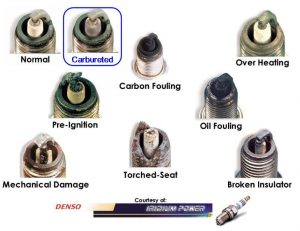 Spark plugs can tell you a lot about the condition of your engine.
Spark plugs can tell you a lot about the condition of your engine.Mind the Gap
Your repair manual will tell you what the gap for the spark plug is supposed to be. The gap refers to the distance between the center electrode and the lateral electrode and is usually measured in millimeters or fractions of an inch. In most instances, spark plugs should be gapped according to the manufacturer's recommended spacing. Extreme care should be taken when checking and setting the gap on platinum and iridium spark plugs, as the center electrode is typically a very fine wire that is easily damaged.
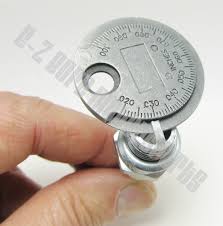 Gapping a spark plug with a disc-type gapping tool.
Gapping a spark plug with a disc-type gapping tool.Never bend or pry on the center electrode. They are delicate and can break internally, causing a plug to fail. Automotive parts stores will sell a variety of spark plug gap measuring tools. The most common is a small, disc-shaped tool with a graduated ramp and measurements around the outside. Simply slide the plug around the ramp until it gently touches and looks at the measurement. If it is not correct, use the disc tool to gently open or close the gap by bending the lateral electrode.
To Clean or Replace Spark Plugs, That is the Question
Whether a plug can be cleaned depends largely on the material used to make the plug. Many modern vehicles use noble metals, like iridium and platinum for the center electrode. These cannot be cleaned and must be replaced. Attempting to clean noble plugs can strip away the metal and cause poor engine performance. Copper electrode plugs can be cleaned with a wire brush, chemicals, and even ultrasonic cleaners, but should be replaced if the deposits are difficult to remove.
Noble metal ones can be quite expensive, and when changing plugs on an eight-cylinder engine, it can add up to a lot of money. If your vehicle manufacturer recommends iridium or platinum models, do not try and save money by using copper ones instead.
A car or truck with fresh plugs will achieve better fuel efficiency, provide better performance and run better for longer. While the procedure may seem intimidating, the average home mechanic or car enthusiast can replace spark plugs in a few hours or less, and doing this simple job yourself can save you a lot of money over the expensive hourly rates charged by repair shops.
An automotive workshop manual or repair guide should be the first thing you have before starting any repairs on your car, and the information available will help you make the right purchases and install your new plugs correctly for a professional-quality repair.
